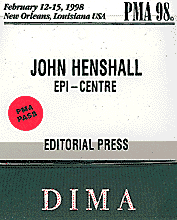A Report from PMA, February 1998
by John Henshall

A Report from PMA, February 1998
by John Henshall

The Photo Marketing Association holds a conference and trade show each year. Just before it, the PMA offshoot, the Digital Imaging Marketing Association, holds a one-day conference. This year and last, the events were held in New Orleans, Louisiana. For the next two years they will be held in Las Vegas, Nevada.
The Ernest N Morial Convention Center

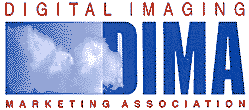
PMA is big but quite unlike the annual Focus on Imaging event in the UK, being very much for the photo trade. The emphasis is on marketing and selling products. It's about business - and what's wrong with that?
Photographers and creative photography are never much in evidence,
though this year full marks go to Olympus for flying-in David Bailey
for the opening of his exhibition at New Orleans' superb 'A Gallery
For Fine Photography'. New products abound - products which often do
not find their way to Britain for some months. In this way PMA
provides us with a reliable and fascinating crystal ball.
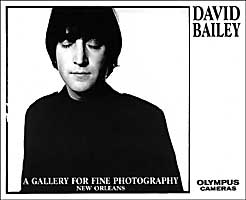
Mr and Mrs David Bailey at PMA New
Orleans
EVERY 35mm CAMERA A DIGITAL CAMERA
The evening before the PMA trade show was about to open, a little publicised press conference announced a forthcoming product which could have a major effect on the future of digital imaging.
Imagek, the image capturing systems unit of Irvine Sensors Corporation of California, announced a new Electronic Film System - the EFS-1 - which they claim will turn any regular 35mm film stills camera into a digital camera simply by inserting a 'digital film' cassette. They expect to demonstrate a working prototype in spring and have the product in the stores by summer for under US$1,000.
 EFS-1
will look like a standard 35mm film cassette, which fits into the
camera's film cavity, with a rigid tongue sticking out. Mounted on
this is a 1.3 megapixel (1,280 x 1,024) CMOS sensor which locates in
the film plane. The cassette holds 40MB of storage and a standard
camera battery.
EFS-1
will look like a standard 35mm film cassette, which fits into the
camera's film cavity, with a rigid tongue sticking out. Mounted on
this is a 1.3 megapixel (1,280 x 1,024) CMOS sensor which locates in
the film plane. The cassette holds 40MB of storage and a standard
camera battery.
The unit is switched on by exposing it to light - take one shot to wake the device and a beep tells you it's ready. Thirty pictures can be taken, at a rate of one shot every two seconds, before the storage is full. The unit automatically powers-down after shooting.
To continue shooting when the storage is full, the images must first be downloaded and deleted, or you could just insert another EFS-1 - just like inserting a new film. The far end of the tongue, away from the cassette, has contacts which enable it to be slotted into a PCMCIA slot. This makes a PCMCIA card reader essential, though no cables are required.
Imagek are not the first to have had the dream of making 'digital film'. The problems are huge.
The joint between the cassette and rigid tongue would need to be a
masterpiece of engineering. It would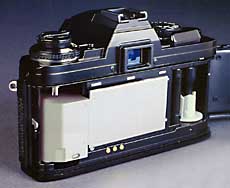 also be very prone to damage. The delicate sensor would need
shielding from dust and damage in a photographers' bag or in the
PCMCIA slot of a laptop.
also be very prone to damage. The delicate sensor would need
shielding from dust and damage in a photographers' bag or in the
PCMCIA slot of a laptop.
All the image processing would be done by software outside the camera. The cassette would need DX coding, to relay the correct ISO equivalence to the camera's exposure system. There would also be camera-specific problems to solve: for example, the cassette-to-image plane varies between cameras and some bodies will not release the shutter unless a film is winding on. A viewfinder mask would be needed, because the sensor area is smaller than the 24 x 36mm film area.
If these problems are overcome, the advantages will be enormous, the ramifications far reaching. No special camera bodies would be needed for digital - just use your existing favourite, even if that's an original Nikon F.
FUJI MX-700
 The
new Fuji MX-700 has a 1,280 x 1,024 (total 1,310,720 pixels)
half-inch CCD. The ISO equivalence of the camera is 100, the shutter
has automatically selected speeds from 1/1,000 to 1/4 second, optical
viewfinder, 2 inch colour LCD monitor, ƒ3.2 lens equivalent to
35mm focal length on a 35mm film camera, autofocus with macro,
built-in flash, video output and the camera comes with a 2MB
SmartMedia data storage card. All the main functions are controlled
by a rotating dial with settings which will be familiar to those who
have used earlier Fuji digital cameras. Fuji also provide a smaller,
lighter, more powerful rechargeable Lithium Ion battery. The camera
is only 3.15 x 4 x 1.3 inches and weight just under 10 ounces.
'Estimated' price is US$799.
The
new Fuji MX-700 has a 1,280 x 1,024 (total 1,310,720 pixels)
half-inch CCD. The ISO equivalence of the camera is 100, the shutter
has automatically selected speeds from 1/1,000 to 1/4 second, optical
viewfinder, 2 inch colour LCD monitor, ƒ3.2 lens equivalent to
35mm focal length on a 35mm film camera, autofocus with macro,
built-in flash, video output and the camera comes with a 2MB
SmartMedia data storage card. All the main functions are controlled
by a rotating dial with settings which will be familiar to those who
have used earlier Fuji digital cameras. Fuji also provide a smaller,
lighter, more powerful rechargeable Lithium Ion battery. The camera
is only 3.15 x 4 x 1.3 inches and weight just under 10 ounces.
'Estimated' price is US$799.
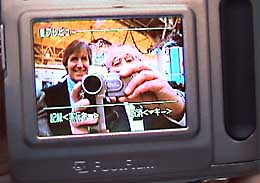
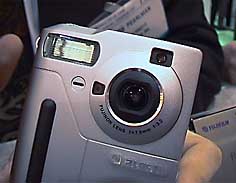
In its brushed aluminium alloy body, the MX-700 is a highly desirable item of silicon jewellery and will be sought after for this reason alone. Almost as a bonus, it's a great little camera which produces lovely images. The ultimate digital camera should be a real winner.

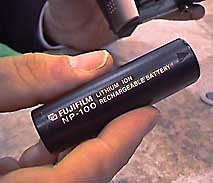
SONY
 Sony
showed a camera set-up for studio portraiture, though it would also
be suitable for many other commercial and scientific applications,
though it is not portable and lacks view camera movements.
Sony
showed a camera set-up for studio portraiture, though it would also
be suitable for many other commercial and scientific applications,
though it is not portable and lacks view camera movements.
The back of the DKC-ST5 has a cluster of professional video connectors. This and a large zoom lens confirm that its origins are in the broadcast television market, which Sony knows so well.
A thick multi-cored cable connects the camera head to a separate Processor Unit. The VCL-1205BYS zoom lens has a focal length of 12.5-63mm (35mm film equivalent 50-252mm) and an aperture range of ƒ2 to ƒ16. The camera head produces a portrait (upright) image when mounted horizontally. There is no integral viewfinder - any video monitor can be used. Sony were using a large flat-screen colour LCD fixed to the tripod. The camera is triggered using a hand-held wired remote control. Like the best broadcast television cameras, the DKC-ST5 uses three CCD chips - one each for red, green and blue - mounted on a prism block which analyzes the light. The chips are two-thirds inch 1.4 megapixel progressive scan, mounted with diagonal spatial offset, a technique which enables the resolution to be interpolated to produce a 2,560 x 2,048 pixel image.
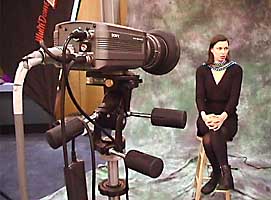

Left: The Sony DKC-ST5 set up for portraiture. Right: The camera's 3 chip sensor mounted on a prism.
ISO settings from 20 through 160 are selectable, with electronic shutter speeds from 4 seconds to 1/10,000 - 1/15 to 1/10,000 with flash. Up to nine frames may be captured in a single burst, at a rate up to two frames per second.
This three-chip camera produces attractive pictures and won the "US$5,000-and-above" award in the Professional Portrait category of the digital camera shootout at the show.
KODAK DCS520 PROFESSIONAL CAMERA

One of the real stars of the show was the new Kodak DCS520 camera, announced in the UK on 2 February 1998. As PMA took place, photographers were getting their hands on the first pre-production models at the Winter Olympics in Nagano. This camera, housed in a Canon EOS 1 body, exudes all the experience that Kodak have gained over seven years of professional digital camera manufacture. No wonder everyone wants one, even at US$14,995 - £9,995 in the UK.
I'll be bringing you a full review next month.
On the last two days of the PMA show, the parades leading up to Mardi Gras were beginning, stealing attention from the show halls and proving that there is life outside photo marketing after all - especially when pretty girls are baring their breasts in the streets. We just came home.
